Effective Communication Strategies for Managers at ABC Company
VerifiedAdded on 2023/06/04
|9
|2166
|330
Report
AI Summary
This report, prepared for the CEO of ABC Company, investigates why managers should prioritize effective communication within the organization. It examines personal and interpersonal aspects of communication, including persuasion techniques and the grapevine, and explores formal communication channels, such as downward, upward, and horizontal communication strategies. The report also addresses communication issues arising from workplace diversity and lack of listening skills. It highlights the advantages and disadvantages of both formal and informal communication channels and concludes that effective communication is crucial for achieving organizational goals, motivating employees, and creating a positive work environment. Desklib provides a platform for students to access similar solved assignments and study resources.
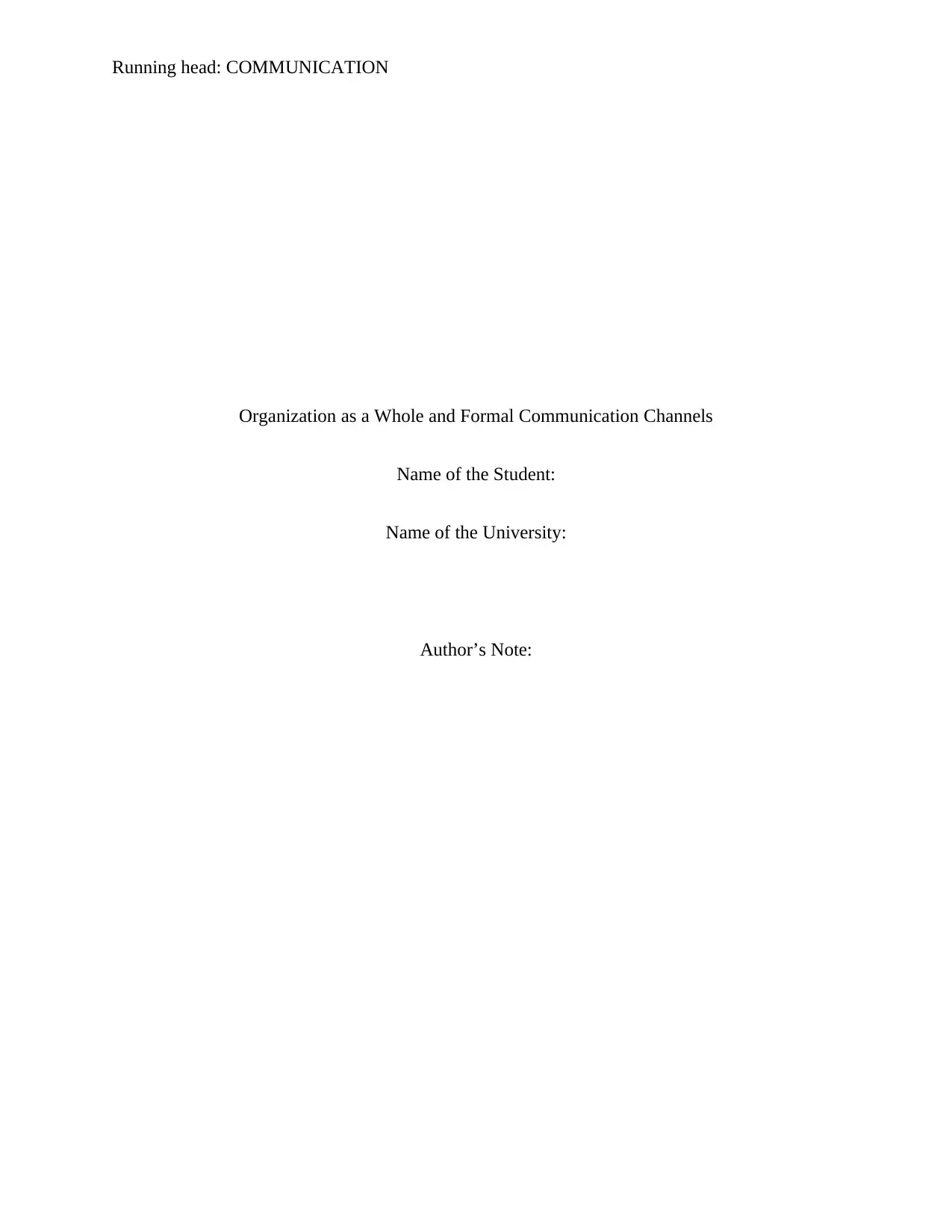
Running head: COMMUNICATION
Organization as a Whole and Formal Communication Channels
Name of the Student:
Name of the University:
Author’s Note:
Organization as a Whole and Formal Communication Channels
Name of the Student:
Name of the University:
Author’s Note:
Paraphrase This Document
Need a fresh take? Get an instant paraphrase of this document with our AI Paraphraser
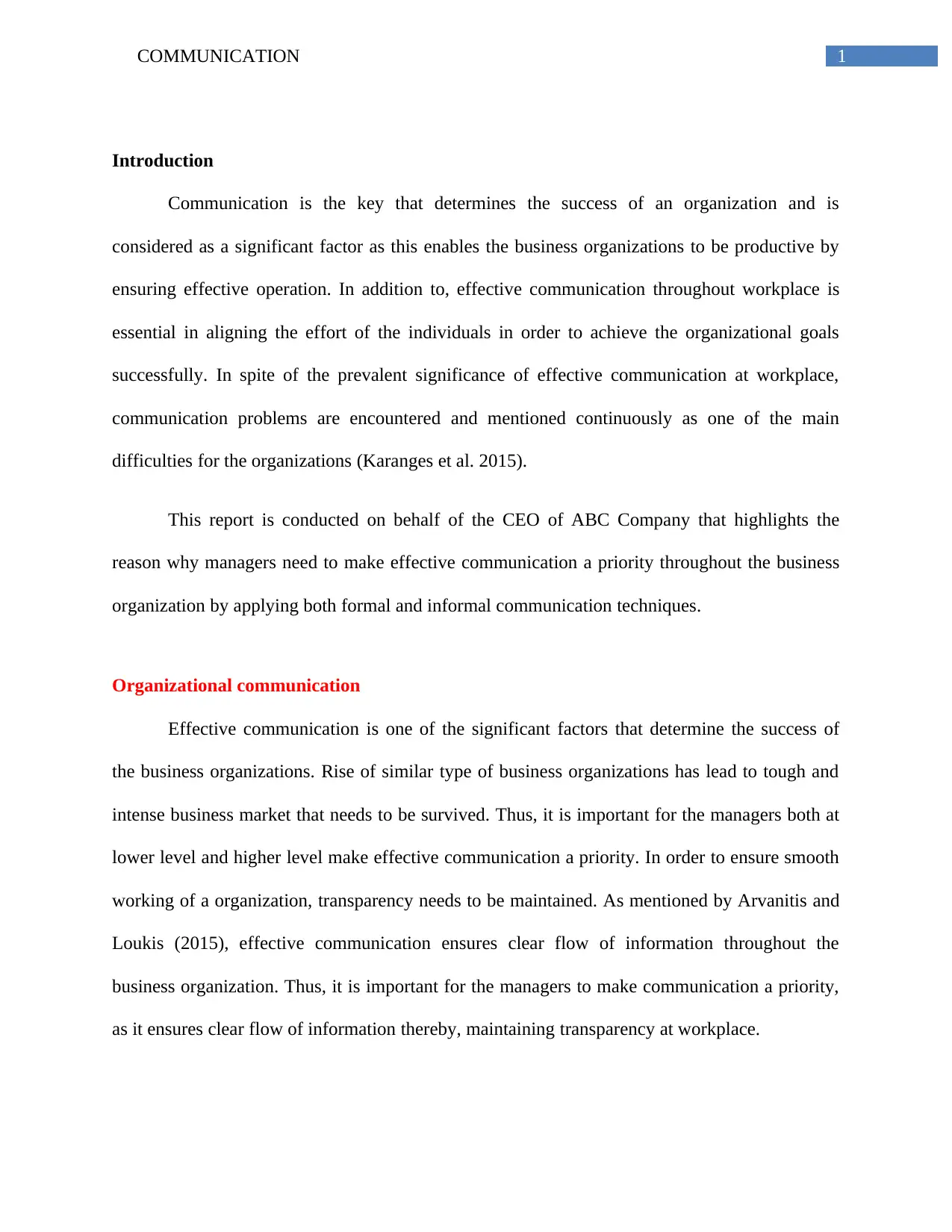
1COMMUNICATION
Introduction
Communication is the key that determines the success of an organization and is
considered as a significant factor as this enables the business organizations to be productive by
ensuring effective operation. In addition to, effective communication throughout workplace is
essential in aligning the effort of the individuals in order to achieve the organizational goals
successfully. In spite of the prevalent significance of effective communication at workplace,
communication problems are encountered and mentioned continuously as one of the main
difficulties for the organizations (Karanges et al. 2015).
This report is conducted on behalf of the CEO of ABC Company that highlights the
reason why managers need to make effective communication a priority throughout the business
organization by applying both formal and informal communication techniques.
Organizational communication
Effective communication is one of the significant factors that determine the success of
the business organizations. Rise of similar type of business organizations has lead to tough and
intense business market that needs to be survived. Thus, it is important for the managers both at
lower level and higher level make effective communication a priority. In order to ensure smooth
working of a organization, transparency needs to be maintained. As mentioned by Arvanitis and
Loukis (2015), effective communication ensures clear flow of information throughout the
business organization. Thus, it is important for the managers to make communication a priority,
as it ensures clear flow of information thereby, maintaining transparency at workplace.
Introduction
Communication is the key that determines the success of an organization and is
considered as a significant factor as this enables the business organizations to be productive by
ensuring effective operation. In addition to, effective communication throughout workplace is
essential in aligning the effort of the individuals in order to achieve the organizational goals
successfully. In spite of the prevalent significance of effective communication at workplace,
communication problems are encountered and mentioned continuously as one of the main
difficulties for the organizations (Karanges et al. 2015).
This report is conducted on behalf of the CEO of ABC Company that highlights the
reason why managers need to make effective communication a priority throughout the business
organization by applying both formal and informal communication techniques.
Organizational communication
Effective communication is one of the significant factors that determine the success of
the business organizations. Rise of similar type of business organizations has lead to tough and
intense business market that needs to be survived. Thus, it is important for the managers both at
lower level and higher level make effective communication a priority. In order to ensure smooth
working of a organization, transparency needs to be maintained. As mentioned by Arvanitis and
Loukis (2015), effective communication ensures clear flow of information throughout the
business organization. Thus, it is important for the managers to make communication a priority,
as it ensures clear flow of information thereby, maintaining transparency at workplace.
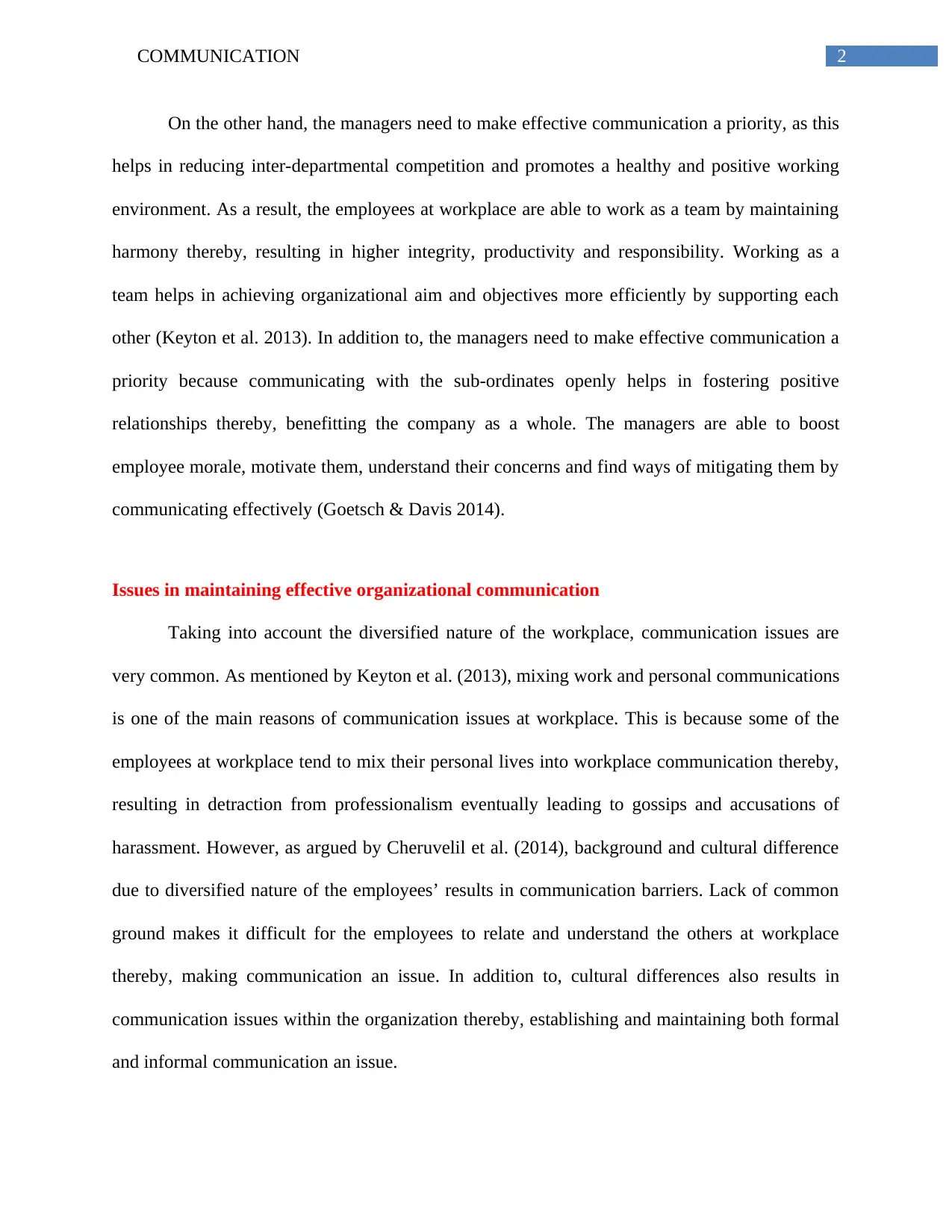
2COMMUNICATION
On the other hand, the managers need to make effective communication a priority, as this
helps in reducing inter-departmental competition and promotes a healthy and positive working
environment. As a result, the employees at workplace are able to work as a team by maintaining
harmony thereby, resulting in higher integrity, productivity and responsibility. Working as a
team helps in achieving organizational aim and objectives more efficiently by supporting each
other (Keyton et al. 2013). In addition to, the managers need to make effective communication a
priority because communicating with the sub-ordinates openly helps in fostering positive
relationships thereby, benefitting the company as a whole. The managers are able to boost
employee morale, motivate them, understand their concerns and find ways of mitigating them by
communicating effectively (Goetsch & Davis 2014).
Issues in maintaining effective organizational communication
Taking into account the diversified nature of the workplace, communication issues are
very common. As mentioned by Keyton et al. (2013), mixing work and personal communications
is one of the main reasons of communication issues at workplace. This is because some of the
employees at workplace tend to mix their personal lives into workplace communication thereby,
resulting in detraction from professionalism eventually leading to gossips and accusations of
harassment. However, as argued by Cheruvelil et al. (2014), background and cultural difference
due to diversified nature of the employees’ results in communication barriers. Lack of common
ground makes it difficult for the employees to relate and understand the others at workplace
thereby, making communication an issue. In addition to, cultural differences also results in
communication issues within the organization thereby, establishing and maintaining both formal
and informal communication an issue.
On the other hand, the managers need to make effective communication a priority, as this
helps in reducing inter-departmental competition and promotes a healthy and positive working
environment. As a result, the employees at workplace are able to work as a team by maintaining
harmony thereby, resulting in higher integrity, productivity and responsibility. Working as a
team helps in achieving organizational aim and objectives more efficiently by supporting each
other (Keyton et al. 2013). In addition to, the managers need to make effective communication a
priority because communicating with the sub-ordinates openly helps in fostering positive
relationships thereby, benefitting the company as a whole. The managers are able to boost
employee morale, motivate them, understand their concerns and find ways of mitigating them by
communicating effectively (Goetsch & Davis 2014).
Issues in maintaining effective organizational communication
Taking into account the diversified nature of the workplace, communication issues are
very common. As mentioned by Keyton et al. (2013), mixing work and personal communications
is one of the main reasons of communication issues at workplace. This is because some of the
employees at workplace tend to mix their personal lives into workplace communication thereby,
resulting in detraction from professionalism eventually leading to gossips and accusations of
harassment. However, as argued by Cheruvelil et al. (2014), background and cultural difference
due to diversified nature of the employees’ results in communication barriers. Lack of common
ground makes it difficult for the employees to relate and understand the others at workplace
thereby, making communication an issue. In addition to, cultural differences also results in
communication issues within the organization thereby, establishing and maintaining both formal
and informal communication an issue.
⊘ This is a preview!⊘
Do you want full access?
Subscribe today to unlock all pages.

Trusted by 1+ million students worldwide
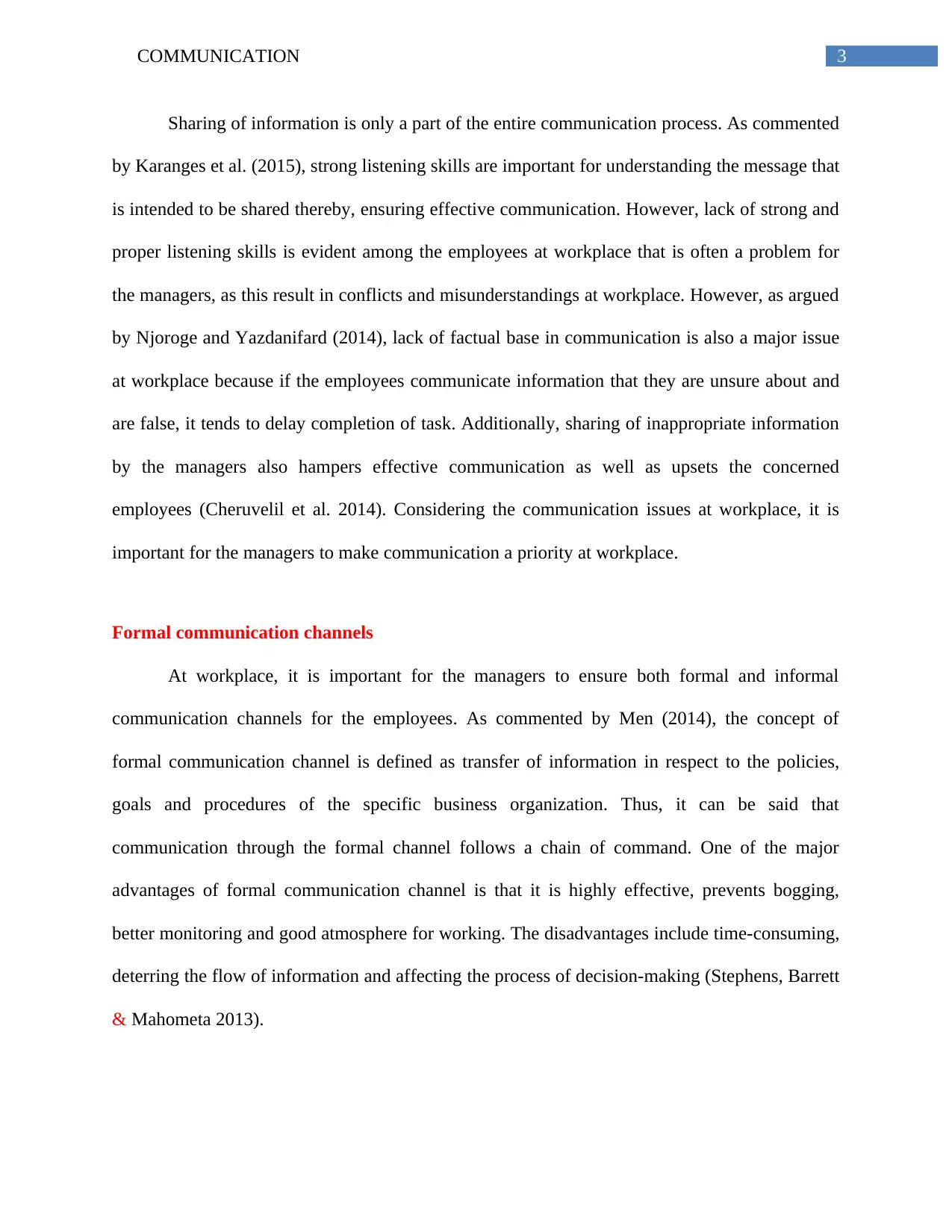
3COMMUNICATION
Sharing of information is only a part of the entire communication process. As commented
by Karanges et al. (2015), strong listening skills are important for understanding the message that
is intended to be shared thereby, ensuring effective communication. However, lack of strong and
proper listening skills is evident among the employees at workplace that is often a problem for
the managers, as this result in conflicts and misunderstandings at workplace. However, as argued
by Njoroge and Yazdanifard (2014), lack of factual base in communication is also a major issue
at workplace because if the employees communicate information that they are unsure about and
are false, it tends to delay completion of task. Additionally, sharing of inappropriate information
by the managers also hampers effective communication as well as upsets the concerned
employees (Cheruvelil et al. 2014). Considering the communication issues at workplace, it is
important for the managers to make communication a priority at workplace.
Formal communication channels
At workplace, it is important for the managers to ensure both formal and informal
communication channels for the employees. As commented by Men (2014), the concept of
formal communication channel is defined as transfer of information in respect to the policies,
goals and procedures of the specific business organization. Thus, it can be said that
communication through the formal channel follows a chain of command. One of the major
advantages of formal communication channel is that it is highly effective, prevents bogging,
better monitoring and good atmosphere for working. The disadvantages include time-consuming,
deterring the flow of information and affecting the process of decision-making (Stephens, Barrett
& Mahometa 2013).
Sharing of information is only a part of the entire communication process. As commented
by Karanges et al. (2015), strong listening skills are important for understanding the message that
is intended to be shared thereby, ensuring effective communication. However, lack of strong and
proper listening skills is evident among the employees at workplace that is often a problem for
the managers, as this result in conflicts and misunderstandings at workplace. However, as argued
by Njoroge and Yazdanifard (2014), lack of factual base in communication is also a major issue
at workplace because if the employees communicate information that they are unsure about and
are false, it tends to delay completion of task. Additionally, sharing of inappropriate information
by the managers also hampers effective communication as well as upsets the concerned
employees (Cheruvelil et al. 2014). Considering the communication issues at workplace, it is
important for the managers to make communication a priority at workplace.
Formal communication channels
At workplace, it is important for the managers to ensure both formal and informal
communication channels for the employees. As commented by Men (2014), the concept of
formal communication channel is defined as transfer of information in respect to the policies,
goals and procedures of the specific business organization. Thus, it can be said that
communication through the formal channel follows a chain of command. One of the major
advantages of formal communication channel is that it is highly effective, prevents bogging,
better monitoring and good atmosphere for working. The disadvantages include time-consuming,
deterring the flow of information and affecting the process of decision-making (Stephens, Barrett
& Mahometa 2013).
Paraphrase This Document
Need a fresh take? Get an instant paraphrase of this document with our AI Paraphraser
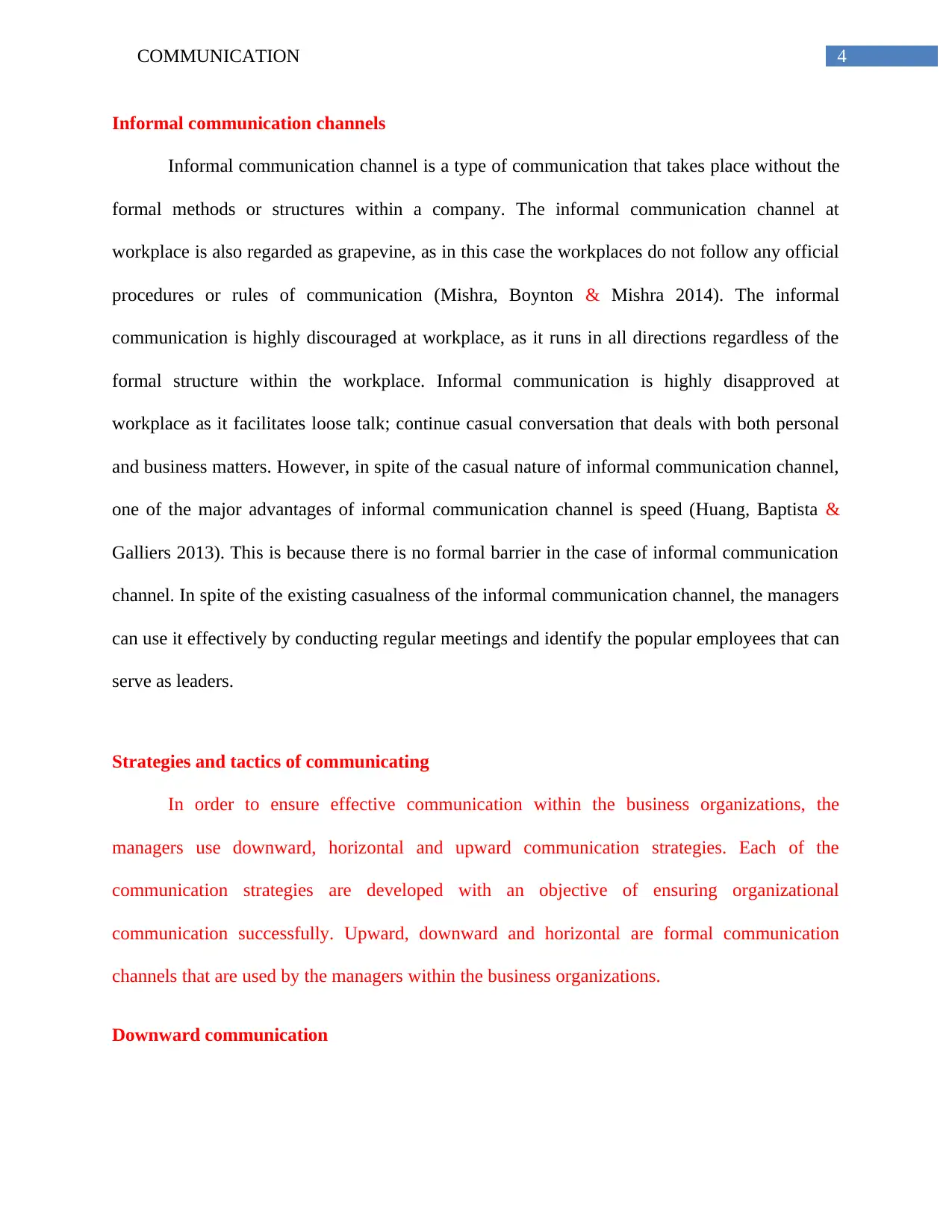
4COMMUNICATION
Informal communication channels
Informal communication channel is a type of communication that takes place without the
formal methods or structures within a company. The informal communication channel at
workplace is also regarded as grapevine, as in this case the workplaces do not follow any official
procedures or rules of communication (Mishra, Boynton & Mishra 2014). The informal
communication is highly discouraged at workplace, as it runs in all directions regardless of the
formal structure within the workplace. Informal communication is highly disapproved at
workplace as it facilitates loose talk; continue casual conversation that deals with both personal
and business matters. However, in spite of the casual nature of informal communication channel,
one of the major advantages of informal communication channel is speed (Huang, Baptista &
Galliers 2013). This is because there is no formal barrier in the case of informal communication
channel. In spite of the existing casualness of the informal communication channel, the managers
can use it effectively by conducting regular meetings and identify the popular employees that can
serve as leaders.
Strategies and tactics of communicating
In order to ensure effective communication within the business organizations, the
managers use downward, horizontal and upward communication strategies. Each of the
communication strategies are developed with an objective of ensuring organizational
communication successfully. Upward, downward and horizontal are formal communication
channels that are used by the managers within the business organizations.
Downward communication
Informal communication channels
Informal communication channel is a type of communication that takes place without the
formal methods or structures within a company. The informal communication channel at
workplace is also regarded as grapevine, as in this case the workplaces do not follow any official
procedures or rules of communication (Mishra, Boynton & Mishra 2014). The informal
communication is highly discouraged at workplace, as it runs in all directions regardless of the
formal structure within the workplace. Informal communication is highly disapproved at
workplace as it facilitates loose talk; continue casual conversation that deals with both personal
and business matters. However, in spite of the casual nature of informal communication channel,
one of the major advantages of informal communication channel is speed (Huang, Baptista &
Galliers 2013). This is because there is no formal barrier in the case of informal communication
channel. In spite of the existing casualness of the informal communication channel, the managers
can use it effectively by conducting regular meetings and identify the popular employees that can
serve as leaders.
Strategies and tactics of communicating
In order to ensure effective communication within the business organizations, the
managers use downward, horizontal and upward communication strategies. Each of the
communication strategies are developed with an objective of ensuring organizational
communication successfully. Upward, downward and horizontal are formal communication
channels that are used by the managers within the business organizations.
Downward communication
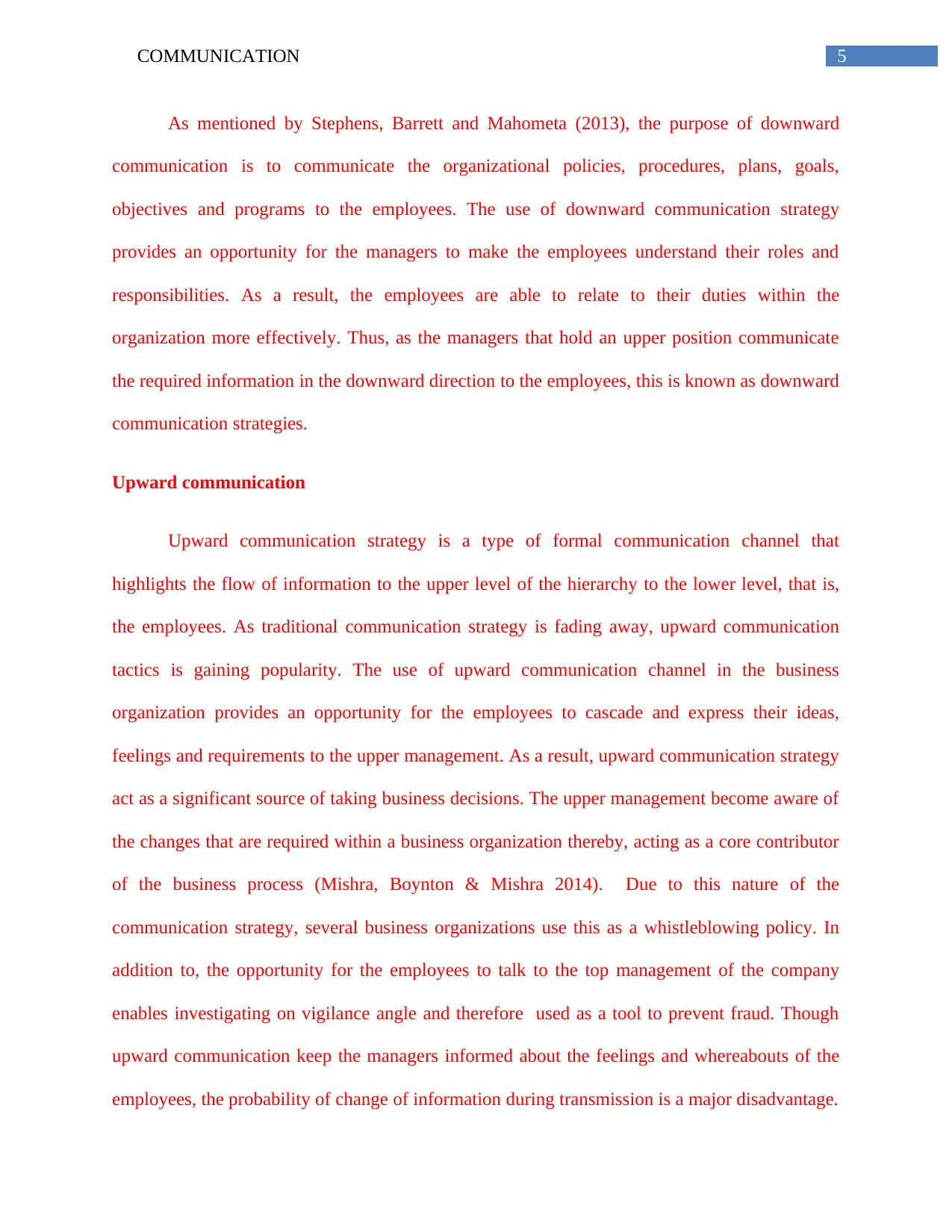
5COMMUNICATION
As mentioned by Stephens, Barrett and Mahometa (2013), the purpose of downward
communication is to communicate the organizational policies, procedures, plans, goals,
objectives and programs to the employees. The use of downward communication strategy
provides an opportunity for the managers to make the employees understand their roles and
responsibilities. As a result, the employees are able to relate to their duties within the
organization more effectively. Thus, as the managers that hold an upper position communicate
the required information in the downward direction to the employees, this is known as downward
communication strategies.
Upward communication
Upward communication strategy is a type of formal communication channel that
highlights the flow of information to the upper level of the hierarchy to the lower level, that is,
the employees. As traditional communication strategy is fading away, upward communication
tactics is gaining popularity. The use of upward communication channel in the business
organization provides an opportunity for the employees to cascade and express their ideas,
feelings and requirements to the upper management. As a result, upward communication strategy
act as a significant source of taking business decisions. The upper management become aware of
the changes that are required within a business organization thereby, acting as a core contributor
of the business process (Mishra, Boynton & Mishra 2014). Due to this nature of the
communication strategy, several business organizations use this as a whistleblowing policy. In
addition to, the opportunity for the employees to talk to the top management of the company
enables investigating on vigilance angle and therefore used as a tool to prevent fraud. Though
upward communication keep the managers informed about the feelings and whereabouts of the
employees, the probability of change of information during transmission is a major disadvantage.
As mentioned by Stephens, Barrett and Mahometa (2013), the purpose of downward
communication is to communicate the organizational policies, procedures, plans, goals,
objectives and programs to the employees. The use of downward communication strategy
provides an opportunity for the managers to make the employees understand their roles and
responsibilities. As a result, the employees are able to relate to their duties within the
organization more effectively. Thus, as the managers that hold an upper position communicate
the required information in the downward direction to the employees, this is known as downward
communication strategies.
Upward communication
Upward communication strategy is a type of formal communication channel that
highlights the flow of information to the upper level of the hierarchy to the lower level, that is,
the employees. As traditional communication strategy is fading away, upward communication
tactics is gaining popularity. The use of upward communication channel in the business
organization provides an opportunity for the employees to cascade and express their ideas,
feelings and requirements to the upper management. As a result, upward communication strategy
act as a significant source of taking business decisions. The upper management become aware of
the changes that are required within a business organization thereby, acting as a core contributor
of the business process (Mishra, Boynton & Mishra 2014). Due to this nature of the
communication strategy, several business organizations use this as a whistleblowing policy. In
addition to, the opportunity for the employees to talk to the top management of the company
enables investigating on vigilance angle and therefore used as a tool to prevent fraud. Though
upward communication keep the managers informed about the feelings and whereabouts of the
employees, the probability of change of information during transmission is a major disadvantage.
⊘ This is a preview!⊘
Do you want full access?
Subscribe today to unlock all pages.

Trusted by 1+ million students worldwide
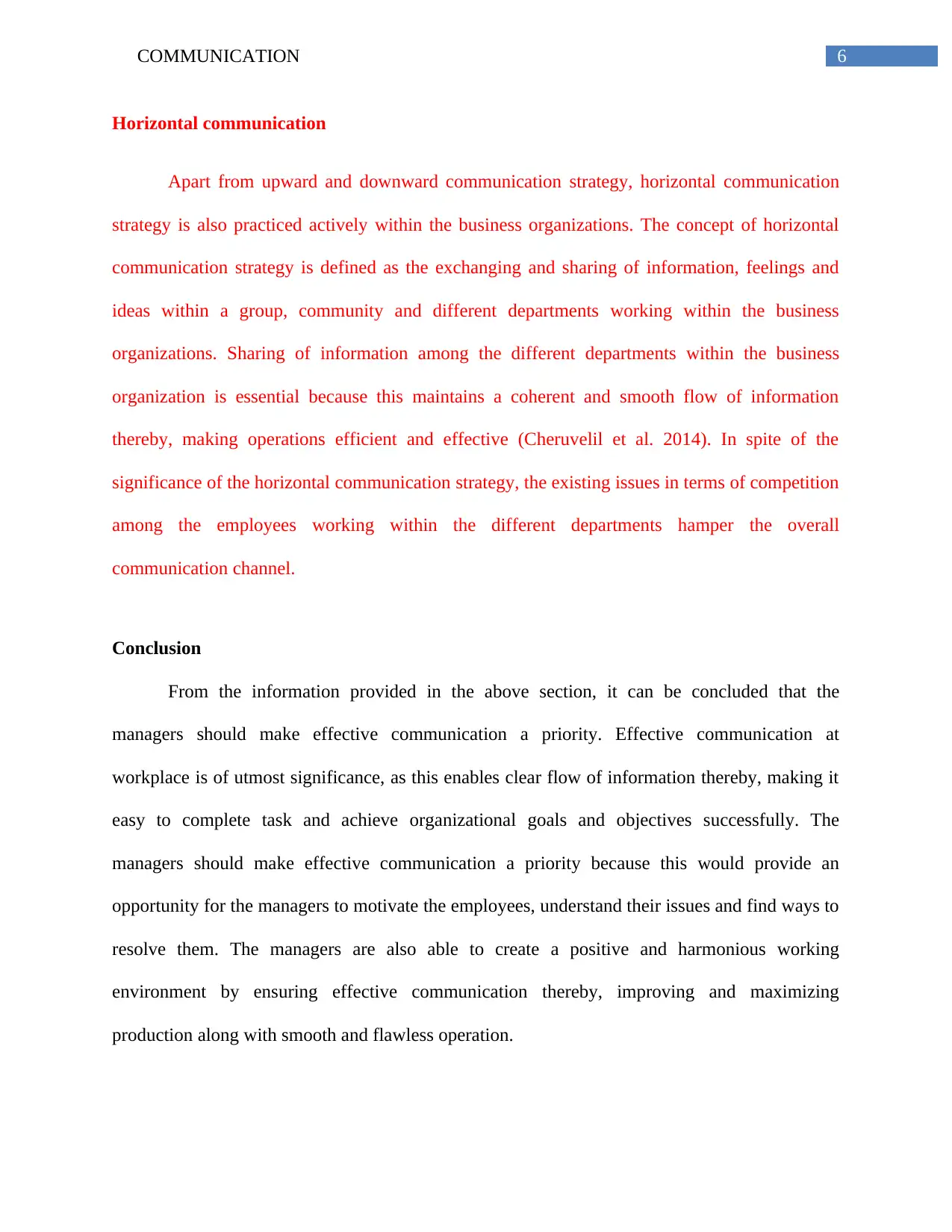
6COMMUNICATION
Horizontal communication
Apart from upward and downward communication strategy, horizontal communication
strategy is also practiced actively within the business organizations. The concept of horizontal
communication strategy is defined as the exchanging and sharing of information, feelings and
ideas within a group, community and different departments working within the business
organizations. Sharing of information among the different departments within the business
organization is essential because this maintains a coherent and smooth flow of information
thereby, making operations efficient and effective (Cheruvelil et al. 2014). In spite of the
significance of the horizontal communication strategy, the existing issues in terms of competition
among the employees working within the different departments hamper the overall
communication channel.
Conclusion
From the information provided in the above section, it can be concluded that the
managers should make effective communication a priority. Effective communication at
workplace is of utmost significance, as this enables clear flow of information thereby, making it
easy to complete task and achieve organizational goals and objectives successfully. The
managers should make effective communication a priority because this would provide an
opportunity for the managers to motivate the employees, understand their issues and find ways to
resolve them. The managers are also able to create a positive and harmonious working
environment by ensuring effective communication thereby, improving and maximizing
production along with smooth and flawless operation.
Horizontal communication
Apart from upward and downward communication strategy, horizontal communication
strategy is also practiced actively within the business organizations. The concept of horizontal
communication strategy is defined as the exchanging and sharing of information, feelings and
ideas within a group, community and different departments working within the business
organizations. Sharing of information among the different departments within the business
organization is essential because this maintains a coherent and smooth flow of information
thereby, making operations efficient and effective (Cheruvelil et al. 2014). In spite of the
significance of the horizontal communication strategy, the existing issues in terms of competition
among the employees working within the different departments hamper the overall
communication channel.
Conclusion
From the information provided in the above section, it can be concluded that the
managers should make effective communication a priority. Effective communication at
workplace is of utmost significance, as this enables clear flow of information thereby, making it
easy to complete task and achieve organizational goals and objectives successfully. The
managers should make effective communication a priority because this would provide an
opportunity for the managers to motivate the employees, understand their issues and find ways to
resolve them. The managers are also able to create a positive and harmonious working
environment by ensuring effective communication thereby, improving and maximizing
production along with smooth and flawless operation.
Paraphrase This Document
Need a fresh take? Get an instant paraphrase of this document with our AI Paraphraser
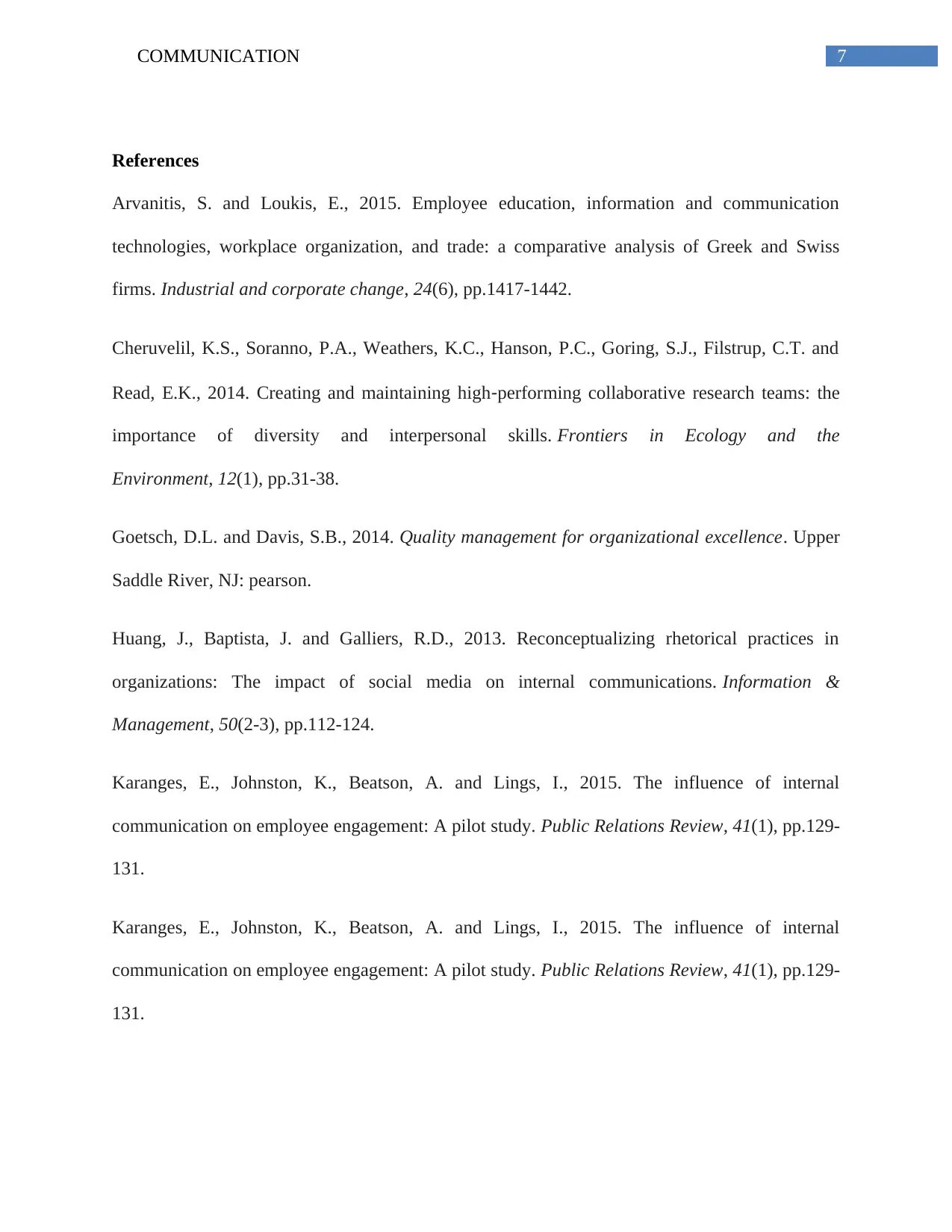
7COMMUNICATION
References
Arvanitis, S. and Loukis, E., 2015. Employee education, information and communication
technologies, workplace organization, and trade: a comparative analysis of Greek and Swiss
firms. Industrial and corporate change, 24(6), pp.1417-1442.
Cheruvelil, K.S., Soranno, P.A., Weathers, K.C., Hanson, P.C., Goring, S.J., Filstrup, C.T. and
Read, E.K., 2014. Creating and maintaining high‐performing collaborative research teams: the
importance of diversity and interpersonal skills. Frontiers in Ecology and the
Environment, 12(1), pp.31-38.
Goetsch, D.L. and Davis, S.B., 2014. Quality management for organizational excellence. Upper
Saddle River, NJ: pearson.
Huang, J., Baptista, J. and Galliers, R.D., 2013. Reconceptualizing rhetorical practices in
organizations: The impact of social media on internal communications. Information &
Management, 50(2-3), pp.112-124.
Karanges, E., Johnston, K., Beatson, A. and Lings, I., 2015. The influence of internal
communication on employee engagement: A pilot study. Public Relations Review, 41(1), pp.129-
131.
Karanges, E., Johnston, K., Beatson, A. and Lings, I., 2015. The influence of internal
communication on employee engagement: A pilot study. Public Relations Review, 41(1), pp.129-
131.
References
Arvanitis, S. and Loukis, E., 2015. Employee education, information and communication
technologies, workplace organization, and trade: a comparative analysis of Greek and Swiss
firms. Industrial and corporate change, 24(6), pp.1417-1442.
Cheruvelil, K.S., Soranno, P.A., Weathers, K.C., Hanson, P.C., Goring, S.J., Filstrup, C.T. and
Read, E.K., 2014. Creating and maintaining high‐performing collaborative research teams: the
importance of diversity and interpersonal skills. Frontiers in Ecology and the
Environment, 12(1), pp.31-38.
Goetsch, D.L. and Davis, S.B., 2014. Quality management for organizational excellence. Upper
Saddle River, NJ: pearson.
Huang, J., Baptista, J. and Galliers, R.D., 2013. Reconceptualizing rhetorical practices in
organizations: The impact of social media on internal communications. Information &
Management, 50(2-3), pp.112-124.
Karanges, E., Johnston, K., Beatson, A. and Lings, I., 2015. The influence of internal
communication on employee engagement: A pilot study. Public Relations Review, 41(1), pp.129-
131.
Karanges, E., Johnston, K., Beatson, A. and Lings, I., 2015. The influence of internal
communication on employee engagement: A pilot study. Public Relations Review, 41(1), pp.129-
131.
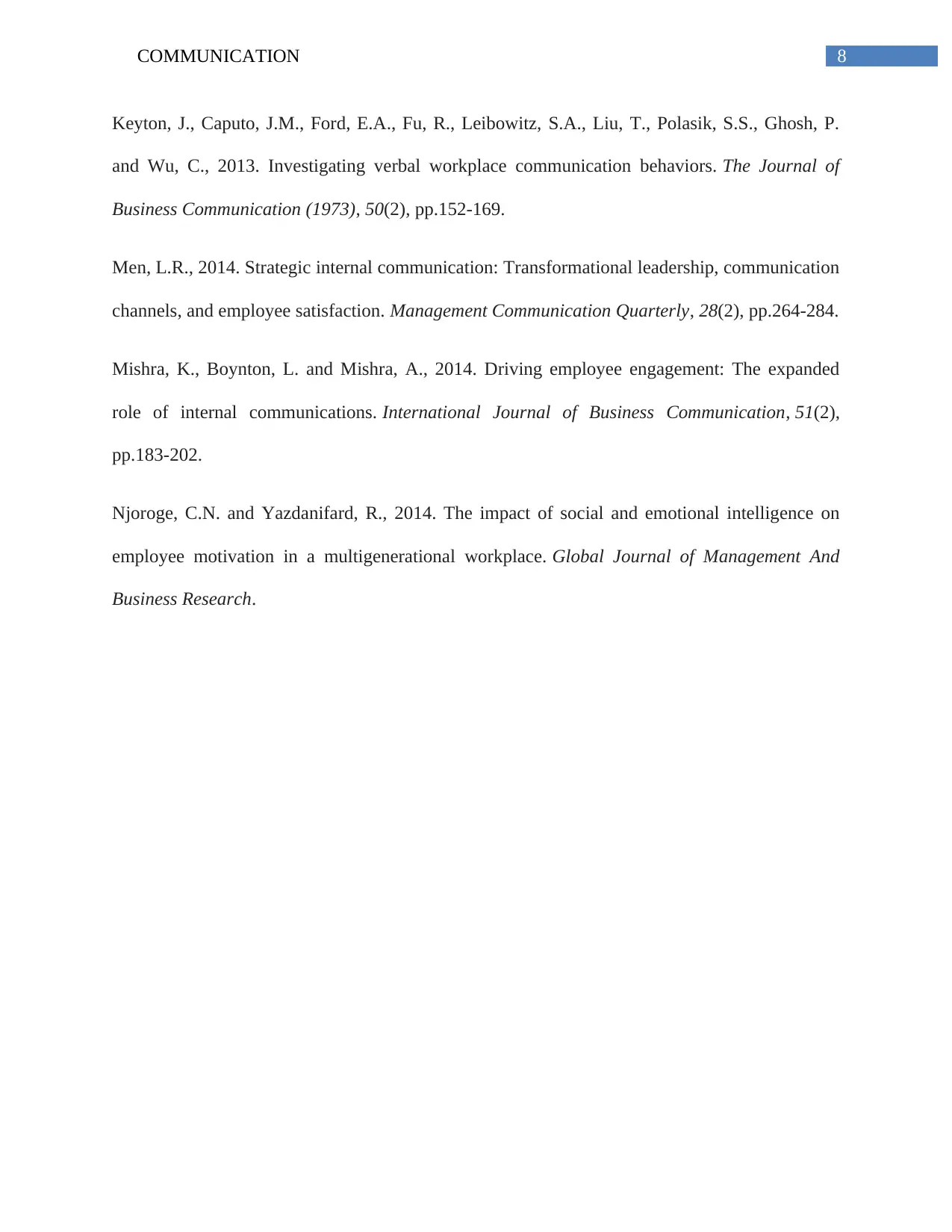
8COMMUNICATION
Keyton, J., Caputo, J.M., Ford, E.A., Fu, R., Leibowitz, S.A., Liu, T., Polasik, S.S., Ghosh, P.
and Wu, C., 2013. Investigating verbal workplace communication behaviors. The Journal of
Business Communication (1973), 50(2), pp.152-169.
Men, L.R., 2014. Strategic internal communication: Transformational leadership, communication
channels, and employee satisfaction. Management Communication Quarterly, 28(2), pp.264-284.
Mishra, K., Boynton, L. and Mishra, A., 2014. Driving employee engagement: The expanded
role of internal communications. International Journal of Business Communication, 51(2),
pp.183-202.
Njoroge, C.N. and Yazdanifard, R., 2014. The impact of social and emotional intelligence on
employee motivation in a multigenerational workplace. Global Journal of Management And
Business Research.
Keyton, J., Caputo, J.M., Ford, E.A., Fu, R., Leibowitz, S.A., Liu, T., Polasik, S.S., Ghosh, P.
and Wu, C., 2013. Investigating verbal workplace communication behaviors. The Journal of
Business Communication (1973), 50(2), pp.152-169.
Men, L.R., 2014. Strategic internal communication: Transformational leadership, communication
channels, and employee satisfaction. Management Communication Quarterly, 28(2), pp.264-284.
Mishra, K., Boynton, L. and Mishra, A., 2014. Driving employee engagement: The expanded
role of internal communications. International Journal of Business Communication, 51(2),
pp.183-202.
Njoroge, C.N. and Yazdanifard, R., 2014. The impact of social and emotional intelligence on
employee motivation in a multigenerational workplace. Global Journal of Management And
Business Research.
⊘ This is a preview!⊘
Do you want full access?
Subscribe today to unlock all pages.

Trusted by 1+ million students worldwide
1 out of 9
Related Documents
Your All-in-One AI-Powered Toolkit for Academic Success.
+13062052269
info@desklib.com
Available 24*7 on WhatsApp / Email
![[object Object]](/_next/static/media/star-bottom.7253800d.svg)
Unlock your academic potential
Copyright © 2020–2025 A2Z Services. All Rights Reserved. Developed and managed by ZUCOL.





